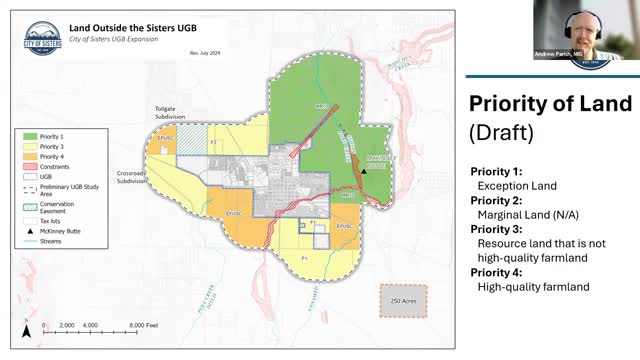City explores land expansion to tackle housing crisis
August 01, 2024 | Sisters, Deschutes County, Oregon

This article was created by AI summarizing key points discussed. AI makes mistakes, so for full details and context, please refer to the video of the full meeting. Please report any errors so we can fix them. Report an error »

In a recent government meeting, officials discussed the ongoing analysis of land use and potential urban growth boundary (UGB) expansions in the area. The meeting focused on identifying sub-areas within the study region, assessing their characteristics, and determining their viability for development.
The steering committee presented findings from their discussions, highlighting the diverse composition of its members, which includes both long-term residents and newcomers. This diversity has contributed to a comprehensive understanding of the land's potential and challenges. The committee identified seven sub-areas, each with unique attributes, ranging from heavily forested lands to regions with existing residential developments.
Key points of discussion included the challenges of integrating forested areas into the urban growth boundary, particularly those designated as priority 3 and 4 lands. The committee expressed concerns about the feasibility of developing these areas, especially those with high-value homes on large lots, which are less likely to support subdivision for higher-density housing.
The committee also noted the importance of engaging with property owners in the identified sub-areas to gather insights on existing homeowners' associations and the developability of the land. A buildable lands inventory will be conducted to assess the potential for accommodating new housing within the urban growth boundary.
Additionally, the meeting touched on a new state initiative aimed at addressing the housing crisis, which allows certain communities to expedite the UGB amendment process for properties up to 50 acres, provided they meet specific criteria, including the provision of affordable housing.
As the city moves forward with its analysis, officials emphasized the need for continued collaboration with the community and stakeholders to ensure that any expansion aligns with the region's growth needs and environmental considerations.
The steering committee presented findings from their discussions, highlighting the diverse composition of its members, which includes both long-term residents and newcomers. This diversity has contributed to a comprehensive understanding of the land's potential and challenges. The committee identified seven sub-areas, each with unique attributes, ranging from heavily forested lands to regions with existing residential developments.
Key points of discussion included the challenges of integrating forested areas into the urban growth boundary, particularly those designated as priority 3 and 4 lands. The committee expressed concerns about the feasibility of developing these areas, especially those with high-value homes on large lots, which are less likely to support subdivision for higher-density housing.
The committee also noted the importance of engaging with property owners in the identified sub-areas to gather insights on existing homeowners' associations and the developability of the land. A buildable lands inventory will be conducted to assess the potential for accommodating new housing within the urban growth boundary.
Additionally, the meeting touched on a new state initiative aimed at addressing the housing crisis, which allows certain communities to expedite the UGB amendment process for properties up to 50 acres, provided they meet specific criteria, including the provision of affordable housing.
As the city moves forward with its analysis, officials emphasized the need for continued collaboration with the community and stakeholders to ensure that any expansion aligns with the region's growth needs and environmental considerations.
View full meeting
This article is based on a recent meeting—watch the full video and explore the complete transcript for deeper insights into the discussion.
View full meeting
